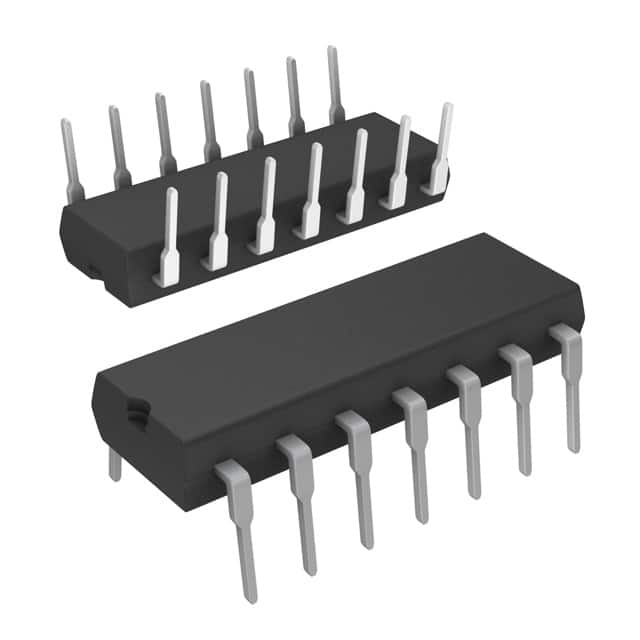74HC7266N,652
Basic Information Overview
- Category: Integrated Circuit (IC)
- Use: Logic Gate
- Characteristics: Quad bilateral switch, high-speed CMOS technology
- Package: SOIC (Small Outline Integrated Circuit)
- Essence: Digital electronic component for signal routing and switching
- Packaging/Quantity: Tape and Reel, 2500 units per reel
Specifications
- Supply Voltage Range: 2V to 6V
- High-Level Input Voltage: 2V to VCC
- Low-Level Input Voltage: GND to 0.8V
- High-Level Output Voltage: VCC - 0.5V
- Low-Level Output Voltage: 0.5V
- On-State Resistance: 70 ohms (typical)
- Propagation Delay Time: 12 ns (typical)
- Operating Temperature Range: -40°C to +125°C
Detailed Pin Configuration
The 74HC7266N,652 has a total of 14 pins arranged as follows:
__ __
A1 -| 1 14 |- VCC
B1 -| 2 13 |- A4
Y1 -| 3 12 |- B4
A2 -| 4 11 |- Y4
B2 -| 5 10 |- A3
Y2 -| 6 9 |- B3
GND -| 7 8 |- Y3
----------
Functional Features
- Quad bilateral switch with independent control inputs
- Allows bidirectional analog or digital signal routing
- High-speed operation due to CMOS technology
- Low power consumption
- Wide supply voltage range for compatibility with various systems
Advantages and Disadvantages
Advantages: - Versatile functionality for signal routing and switching applications - High-speed operation enables efficient data transmission - Low power consumption helps in energy-efficient designs
Disadvantages: - Limited on-state resistance may affect signal quality in certain applications - Sensitivity to electrostatic discharge (ESD) requires proper handling precautions
Working Principles
The 74HC7266N,652 is a quad bilateral switch that operates based on the control inputs provided. When the control input is high, the corresponding switch is turned on, allowing the signal to pass through. Conversely, when the control input is low, the switch is turned off, blocking the signal.
Detailed Application Field Plans
The 74HC7266N,652 finds applications in various fields where signal routing and switching are required. Some of the common application areas include: 1. Audio and video signal routing in multimedia systems 2. Data multiplexing and demultiplexing in communication systems 3. Analog and digital signal switching in test and measurement equipment 4. Signal conditioning and level shifting in industrial automation 5. Logic level translation in microcontroller-based systems
Detailed and Complete Alternative Models
Some alternative models that offer similar functionality to the 74HC7266N,652 are: - CD4066B: Quad bilateral switch IC from Texas Instruments - MC14066B: CMOS analog switch IC from ON Semiconductor - HCF4066: Quad bilateral switch IC from STMicroelectronics - 74HCT4066: High-speed CMOS analog switch IC from NXP Semiconductors
These alternative models can be considered based on specific requirements and availability.
Word count: 345 words
技術ソリューションにおける 74HC7266N,652 の適用に関連する 10 件の一般的な質問と回答をリストします。
Sure! Here are 10 common questions and answers related to the application of 74HC7266N,652:
Q: What is the function of the 74HC7266N,652? A: The 74HC7266N,652 is a quad bilateral switch IC that can be used for signal routing and switching applications.
Q: What is the maximum voltage rating for the 74HC7266N,652? A: The maximum voltage rating for the 74HC7266N,652 is typically around 6V.
Q: How many channels does the 74HC7266N,652 have? A: The 74HC7266N,652 has four independent channels.
Q: What is the typical on-resistance of each channel in the 74HC7266N,652? A: The typical on-resistance of each channel in the 74HC7266N,652 is around 70 ohms.
Q: Can the 74HC7266N,652 handle analog signals? A: Yes, the 74HC7266N,652 can handle both digital and analog signals.
Q: What is the maximum current rating for each channel in the 74HC7266N,652? A: The maximum current rating for each channel in the 74HC7266N,652 is typically around 25mA.
Q: Can the 74HC7266N,652 be used for bidirectional signal routing? A: Yes, the 74HC7266N,652 can be used for bidirectional signal routing.
Q: What is the power supply voltage range for the 74HC7266N,652? A: The power supply voltage range for the 74HC7266N,652 is typically between 2V and 6V.
Q: Can the 74HC7266N,652 be used in high-frequency applications? A: Yes, the 74HC7266N,652 can be used in high-frequency applications, but its performance may be limited at very high frequencies.
Q: Are there any specific precautions to consider when using the 74HC7266N,652? A: It is important to ensure that the input and output voltages are within the specified range to prevent damage to the IC. Additionally, proper decoupling capacitors should be used to minimize noise and ensure stable operation.
Please note that the answers provided here are general and may vary depending on the specific datasheet and manufacturer's recommendations for the 74HC7266N,652.


